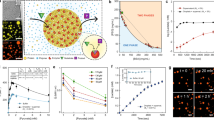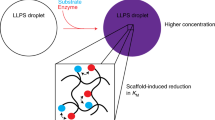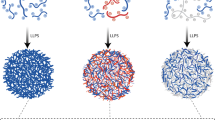Abstract
Enzymatic catalysis is essential to cell survival. In many instances, enzymes that participate in reaction cascades have been shown to assemble into metabolons in response to the presence of the substrate for the first enzyme. However, what triggers metabolon formation has remained an open question. Through a combination of theory and experiments, we show that enzymes in a cascade can assemble via chemotaxis. We apply microfluidic and fluorescent spectroscopy techniques to study the coordinated movement of the first four enzymes of the glycolysis cascade: hexokinase, phosphoglucose isomerase, phosphofructokinase and aldolase. We show that each enzyme independently follows its own specific substrate gradient, which in turn is produced by the preceding enzymatic reaction. Furthermore, we find that the chemotactic assembly of enzymes occurs even under cytosolic crowding conditions.
This is a preview of subscription content, access via your institution
Access options
Access Nature and 54 other Nature Portfolio journals
Get Nature+, our best-value online-access subscription
$29.99 / 30 days
cancel any time
Subscribe to this journal
Receive 12 print issues and online access
$259.00 per year
only $21.58 per issue
Buy this article
- Purchase on SpringerLink
- Instant access to full article PDF
Prices may be subject to local taxes which are calculated during checkout






Similar content being viewed by others
References
Miles, E. W., Rhee, S. & Davies, D. R. The molecular basis of substrate channeling. J. Biol. Chem. 274, 12193–12196 (1999).
Wheeldon, I. et al. Substrate channelling as an approach to cascade reactions. Nat. Chem. 8, 299–309 (2016).
Lin, J.-L., Palomec, L. & Wheeldon, I. Design and analysis of enhanced catalysis in scaffolded multienzyme cascade reactions. ACS Catal. 4, 505–511 (2014).
Yamada, Y. et al. Nanocrystal bilayer for tandem catalysis. Nat. Chem. 3, 372–376 (2011).
Zhao, M. et al. Core–shell palladium nanoparticle@metal–organic frameworks as multifunctional catalysts for cascade reactions. J. Am. Chem. Soc. 136, 1738–1741 (2014).
Zhang, Y. H. Substrate channeling and enzyme complexes for biotechnological applications. Biotechnol. Adv. 29, 715–725 (2011).
An, S., Kumar, R., Sheets, E. D. & Benkovic, S. J. Reversible compartmentalization of de novo purine biosynthetic complexes in living cells. Science 320, 103–106 (2008).
Nishi, H., Hashimoto, K. & Panchenko, A. R. Phosphorylation in protein–protein binding: effect on stability and function. Structure 19, 1807–1815 (2011).
Lindbladh, C. et al. Preparation and kinetic characterization of a fusion protein of yeast mitochondrial citrate synthase and malate-dehydrogenase. Biochemistry 33, 11692–11698 (1994).
Wu, F. & Minteer, S. Krebs cycle metabolon: structural evidence of substrate channeling revealed by cross-linking and mass spectrometry. Angew. Chem. Int. Ed. 54, 1851–1854 (2015).
Winkel-Shirley, B. Evidence for enzyme complexes in the phenylpropanoid and flavonoid pathways. Physiol. Plant. 107, 142–149 (1999).
Jorgensen, K. et al. Metabolon formation and metabolic channeling in the biosynthesis of plant natural products. Curr. Opin. Plant. Biol. 8, 280–291 (2005).
Graham, J. W. A. et al. Glycolytic enzymes associate dynamically with mitochondria in response to respiratory demand and support substrate channeling. Plant Cell 19, 3723–3738 (2007).
Campanella, M. E., Chu, H. & Low, P. S. Assembly and regulation of a glycolytic enzyme complex on the human erythrocyte membrane. Proc. Natl Acad. Sci. USA 102, 2402–2407 (2005).
Sengupta, S. et al. Enzyme molecules as nanomotors. J. Am. Chem. Soc. 135, 1406–1414 (2013).
Sengupta, S. et al. DNA polymerase as a molecular motor and pump. ACS Nano 8, 2410–2418 (2014).
Yu, H., Jo, K., Kounovsky, K. L., Pablo, J. J. & Schwartz, D. C. Molecular propulsion: chemical sensing and chemotaxis of DNA driven by RNA polymerase. J. Am. Chem. Soc. 131, 5722–5723 (2009).
French, J. B. et al. Spatial colocalization and functional link of purinosomes with mitochondria. Science 351, 733–737 (2016).
Kohnhorst, C. L. et al. Identification of a multienzyme complex for glucose metabolism in living cells. J. Biol. Chem. 292, 9191–9203 (2017).
Muddana, H. S., Sengupta, S., Mallouk, T. E., Sen, A. & Butler, P. J. Substrate catalysis enhance single-enzyme diffusion. J. Am. Chem. Soc. 132, 2110–2111 (2010).
Riedel, C. et al. The heat released during catalytic turnover enhances the diffusion of an enzyme. Nature 517, 227–230 (2015).
Illien, P. et al. Exothermicity is not a necessary condition for enhanced diffusion of enzymes. Nano Lett. 17, 4415–4420 (2017).
Myers, T. C., Nakamura, K. & Flesher, J. W. Phosphonic acid analogs of nucleoside phosphate. I. The synthesis of 5′-adenylyl methylenediphosphate, a phosphonic acid analog of ATP. J. Am. Chem. Soc. 85, 3292–3295 (1963).
Paduano, L., Sartorio, R., Errico, G. D. & Vitagliano, V. Mutual diffusion in aqueous solution of ethylene glycol oligomers at 25 °C. J. Chem. Soc. Faraday Trans. 94, 2571–2576 (1998).
Annunziata, O. et al. Quaternary diffusion coefficients in a protein–polymer–salt–water system determined by Rayleigh interferometry. J. Phys. Chem. B 113, 13446–13453 (2009).
Vergara, A., Paduano, L. & Sartorio, R. Mechanism of protein–poly(ethylene glycol) interaction from a diffusive point of view. Macromolecules 35, 1389–1398 (2002).
Vanag, V. K. & Epstein, I. R. Cross-diffusion and pattern formation in reaction–diffusion systems. Phys. Chem. Chem. Phys. 11, 897–912 (2009).
Schurr, J. M., Fujimoto, B. S., Huynh, L. & Chiu, D. T. A theory of macromolecular chemotaxis. J. Phys. Chem. B 117, 7626–7652 (2013).
Wilkinson, K. D. & Rose, I. A. Isotope trapping studies of yeast hexokinase during steady state catalysis. A combined rapid quench and isotope trapping technique. J. Biol. Chem. 254, 12567–12572 (1979).
Bermingham, A., Bottomley, J. R., Derrick, W. U. & Derrick, J. P. Equilibrium and kinetic studies of substrate binding to 6-hydroxymethyl-7,8-dihydropterin pyrophosphokinase from Escherichia coli. J. Biol. Chem. 275, 17962–17967 (2000).
Wu, F., Pelster, L. N. & Minteer, S. D. Krebs cycle metabolon formation: metabolite concentration gradient enhanced compartmentation of sequential enzymes. Chem. Commun. 51, 1244–1247 (2015).
Vopel, T. & Makhatadze, G. I. Enzyme activity in the crowded milieu. PLoS ONE 7, e39418 (2012).
Baum, M., Erdel, F., Wachsmuth, M. & Rippe, K. Retrieving the intracellular topology from multi-scale protein mobility mapping in living cells. Nat. Commun. 5, 4494 (2014).
Acknowledgements
The work was supported by Penn State MRSEC, funded by the National Science Foundation (NSF, DMR-1420620). P.J.B. acknowledges support from NSF CMMI 1334847. H.P. and H.H. acknowledge support by the Defense Threat Reduction Agency (award no. HDTRA1-14-1-0051).
Author information
Authors and Affiliations
Contributions
M.K.G., P.J.B., H.H., S.J.B. and A.S. designed the research. X.Z., V.Y. and M.M.S. performed the experiments. H.P. performed the modelling. X.Z., H.P., V.Y., M.M.S., H.H., S.J.B. and A.S. analysed the data and wrote the manuscript. All authors contributed to the discussion of results.
Corresponding authors
Ethics declarations
Competing interests
M.K.G. has an equity interest in and is a cofounder and scientific advisor of VeraChem LLC.
Supplementary information
Supplementary information
Supplementary information (PDF 1753 kb)
Rights and permissions
About this article
Cite this article
Zhao, X., Palacci, H., Yadav, V. et al. Substrate-driven chemotactic assembly in an enzyme cascade. Nature Chem 10, 311–317 (2018). https://doi.org/10.1038/nchem.2905
Received:
Accepted:
Published:
Issue Date:
DOI: https://doi.org/10.1038/nchem.2905
This article is cited by
-
In vitro construction of the COQ metabolon unveils the molecular determinants of coenzyme Q biosynthesis
Nature Catalysis (2024)
-
In situ enzymatic control of colloidal phoresis and catalysis through hydrolysis of ATP
Nature Communications (2024)
-
Self-organization of primitive metabolic cycles due to non-reciprocal interactions
Nature Communications (2023)
-
Self assembling nanoparticle enzyme clusters provide access to substrate channeling in multienzymatic cascades
Nature Communications (2023)
-
Optimal spatial allocation of enzymes as an investment problem
Communications Physics (2022)




